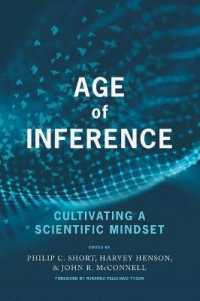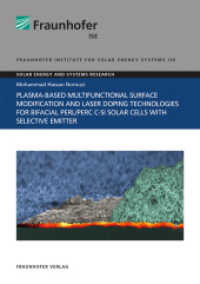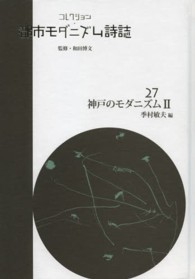Full Description
In an age where we are inundated with information, the ability to discern verifiable information to make proper decisions and solve problems is ever more critical. Modern science, which espouses a systematic approach to making 'inferences,' requires a certain mindset that allows for a degree of comfort with uncertainty.
This book offers inspirations and ideas for cultivating the proper mindset for the studying, teaching, and practicing of science that will be useful for those new to as well as familiar with the field. Although a paradigm shift from traditional instruction is suggested in the National Framework for K-12 science, this volume is intended to help educators develop a personal mental framework in which to transition from a teacher-centered, didactical approach to a student-centered, evidence-guided curriculum.
While the topics of the book derive from currently published literature on STEM education as they relate to the National Framework for K-12 Science and the Three-Dimensional science instruction embedded in the Next Generation Science Standards, this book also examines these topics in the context of a new societal age posited as the 'Age of Inference' and addresses how to make sense of the ever-increasing deluge of information that we are experiencing by having a scientific and properly discerning mindset.
Contents
Foreword; Miranda Feliciano Tyson.
Acknowledgments and Dedication.
Section I. Introduction: The Nature Of Knowledge, Science, And Inference.
Chapter 1. The Age of Inference; John R. McConnell, Sarah B. Dugger, and Philip C. Short.
Chapter 2. Nature of the Scientific Enterprise; Harvey Henson.
Chapter 3. The Nature of Science Education: Relativity of Theory; Philip C. Short.
Chapter 4. Mathematics: Language, Modeling, and Comparison Assisting Inference; Mary Barone Martin, Tammy Jones, Dovie Kimmins, and Teresa Schmidt.
Chapter 5. Statistics: Developing Impactful Teaching and Learning; Mary Barone Martin, Tammy Jones, and Teresa Schmidt.
Chapter 6. Statistics: Assessing Success in the Inference Process; Mary Barone Martin, Tammy Jones, and Teresa Schmidt.
Section II. Application: Framework For Science In A Data-rich World.
Chapter 7. Children's Literature Resources to Support Authentic Science Practices and Environmental Decision-Making: The Conservation Tales Series; Tom J. McConnell and Barbara Giorgio-Booher.
Chapter 8. Supporting Statistical Literacies in the Context of a Data Visualization Project With Elementary Students; Lynn Hodge, Joy Bertling, and Shande King.
Chapter 9. Green Literacy K-5: Nurturing a Scientific Mindset; Jennifer Cullerton Johnson and Mary K. Gove.
Chapter 10. Complex Multimodal Text Sets to Support Science Literacy; William Romine, Amy Lannin, Torrey Palmer, Delinda van Garderen, Rachel Juergensen, Cassandra M. Smith, and William Folk.
Chapter 11. Power Up or Put Away? Using Mobile Phones for Authentic Student Investigations; Kristin T. Rearden and Blanche O'Bannon.
Chapter 12. Self-Regulated Learning Theory to Build Scientific Mindsets for Diversity in STEM; Giuseppina Mattietti and Erin E. Peters-Burton.
Chapter 13. A Case for the Model-Based Reasoning Classroom; Arthur Beauchamp and Cynthia Passmore.
Chapter 14. Cultivating a Scientific Mindset Through Inquiry-Based Science Learning Utilizing Nasa Resources for Educators Bridging the Disconnect Between How We Do and Teach Science: Cultivating a Scientific Mindset in an Era of Data-Driven Education; Jana Bouwma-Gearhart.
Chapter 15. The Scientific Method Card Game: Applications for Any Educational Context; Kallina M. Dunkle.
Chapter 16. Toward a Design-Centered Scientific Mindset: Closing the Opportunity Gaps via 3D Design and Printing in STEM Teacher Education; Lingguo Bu, Harvey Henson, and Euginia Nyirenda.
Section III. Conclusion: The Future For Inferences And Actions.
Chapter 17. Developing Critical Literacy Skills Among Diverse Learners During the Age of Inference; Laveria F. Hutchison.
Chapter 18. Content and Pedagogical Knowledge for Teaching Confidence Intervals in a Post p < 0.05 World; Jennifer J. Kaplan and Kristen E. Roland.
Chapter 19. The Multidimensional Learning Goals for Making Inferences With Data; Ryan Seth Jones, Anna Strimaitis Grinath, and Fonya Scott.
Chapter 20. Expectations and Disciplinary Blends; L. Jeneva Clark, R. Alexander Bentley, Nicholas N. Nagle, and Vasileios Maroulas.
Chapter 21. Machine Learning: A New Lens for Integrating Computational Thinking and Science in the High School Classroom; Michael Daley, Zhen Bai, Raffaella Borasi, and Dave Miller.
Chapter 22. Becoming a Postmodern STEM Teacher Leader in the Age of Inference; Rebekah Hammack.
Chapter 23. Seeking Homeostasis in a Heteroscedastic World: A Sense of the Stakes in the Age of Inference; Philip C. Short, Donna F. Short, and John R. McConnell.
References.
About the Editors.
About the Contributors.








